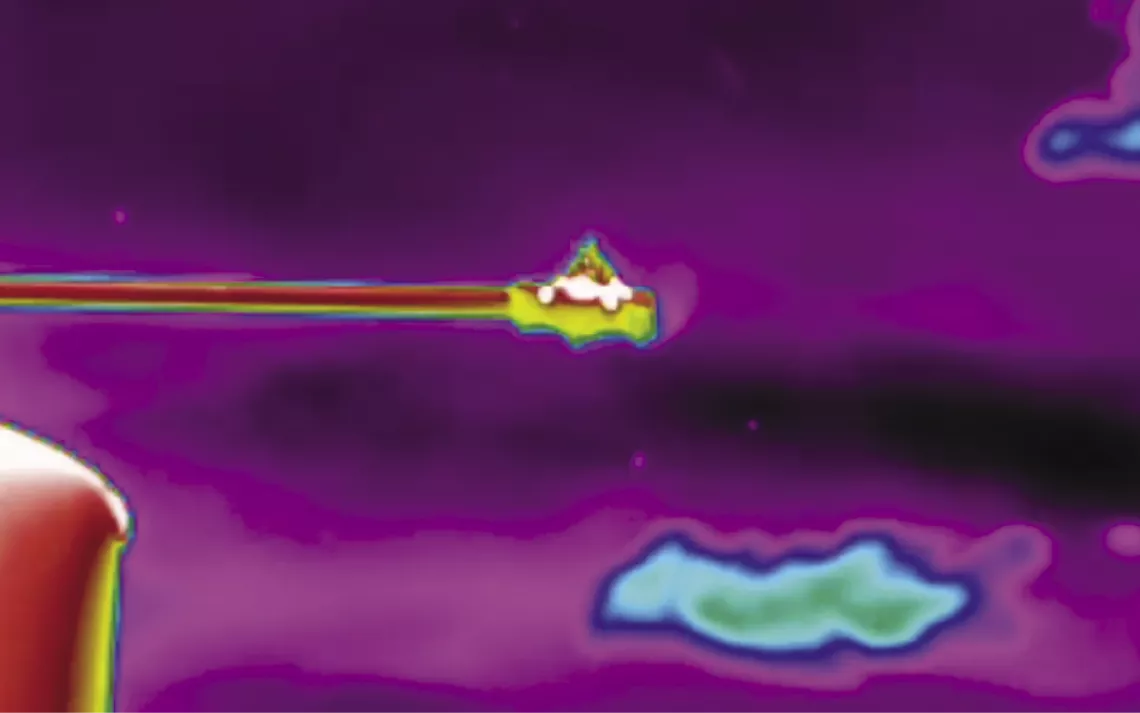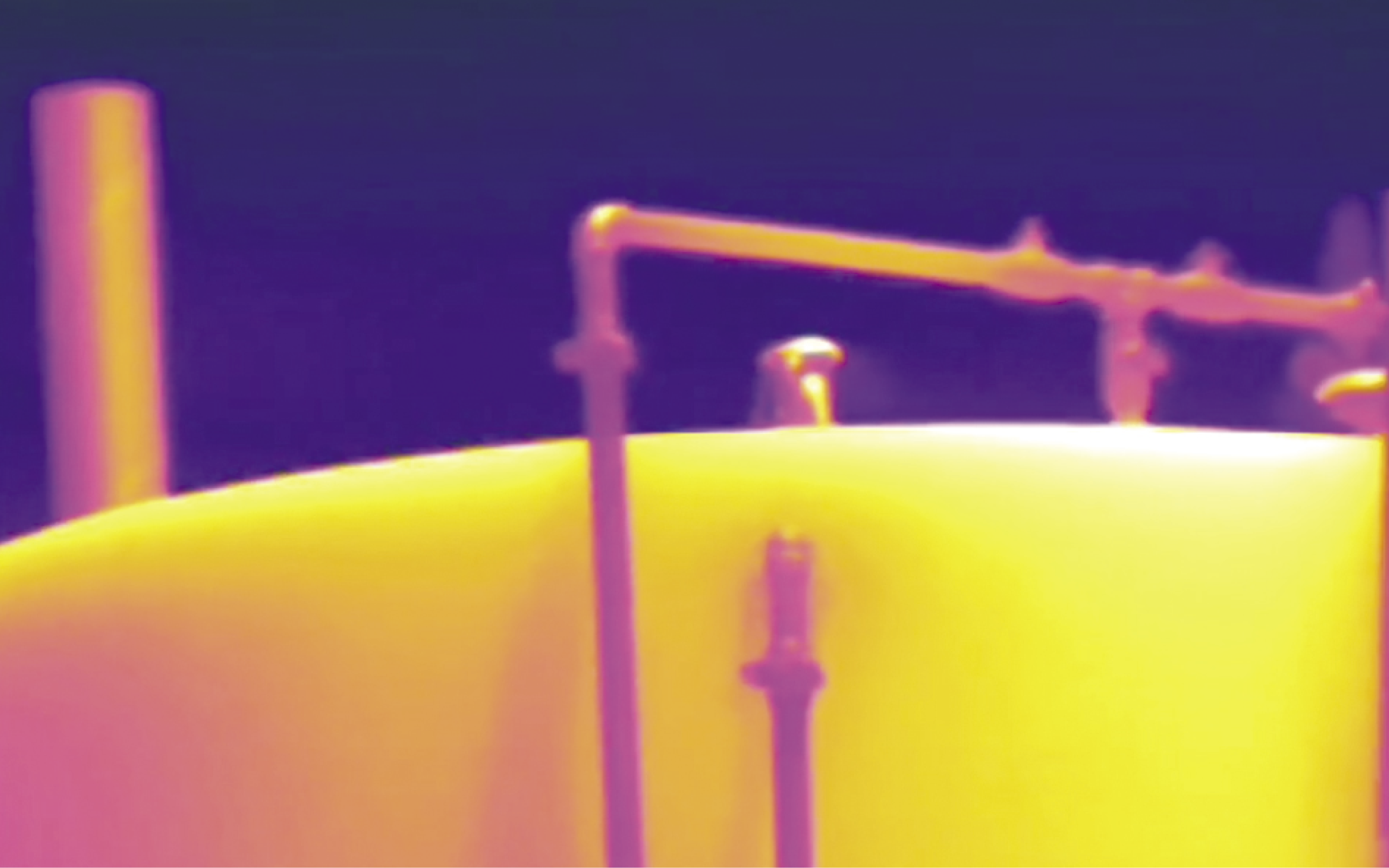Orphaned Gas Wells Continue to Emit Dangerous Methane
Conservationists are using new camera technology to track emissions

Optical gas imaging captures hydrocarbon pollutants venting from a storage tank at an abandoned well site. | Photo by Andrew Klooster/Earthworks
A woodpecker hammered in Colorado's snow-shrouded Medicine Bow–Routt National Forest in November as Andrew Klooster steadied himself on the muddy ground, peering into an optical gas imaging camera. The jerky, grainy black-and-white image on the screen showed a plume of hazy toxic gases spewing out of a pipe that extended from the top of an inactive oil and gas storage tank.
Since 2019, when the owner of the site went bankrupt and left the area for taxpayers to clean up, Klooster has documented methane and volatile organic compounds escaping from the orphaned well on several occasions.

"Nothing has changed since we filed a complaint about this site in June," said Klooster, a Colorado field advocate for the environmental nonprofit Earthworks, who reported his findings to state regulators charged with monitoring the well. The site is the federal government's responsibility to clean up because it's on public land.
"This equipment is sitting here on the landscape, venting pollutants into the air, and no one is coming to take care of them," he said. "There is no timeline."
Klooster is on a mission to hold energy companies and Colorado oil and gas regulators accountable for failing to fix hulking metal tanks, pumpjacks, and pipelines that are leaking pollutants and presenting health, safety, and climate hazards for people and wildlife. The 30-year-old outdoors enthusiast is among the few people outside the fossil fuel industry certified to operate a $100,000 optical gas imaging camera. The sensitive handheld equipment, which before use must cool to -321°F—the temperature of liquid nitrogen—helps him see gases that are not visible to the naked eye. Klooster chooses sites based on residents' concerns about odors and air and water pollution.
"One of our main things is educating the public about this issue so they're aware of the true extent of the pollution left behind by the oil and gas industry," said the thermographer, who formerly tracked contaminants in urban watersheds. "We are building a body of evidence that allows people and regulators to see toxic gases coming off these sites."
Klooster racked up thousands of miles in rental cars in 2021, conducting 266 site visits to 184 facilities on windswept plains, mountaintops, and national monuments. He filed 54 complaints with Colorado regulators about emissions leaking from equipment. The complaints prompted investigations by the state's Air Pollution Control Division, and 21 resulted in repairs. Even then, Klooster doggedly monitored trouble locations.
"On return visits to six sites that had been reportedly repaired, I found the same, or additional, emissions," he said. "On one of these sites, I filed four complaints, each time after a repair had been made from the previous complaint."
The Medicine Bow–Routt National Forest, on the Colorado Western Slope, is among the sites he has returned to. The well in this remote spot, surrounded by towering evergreens and bare-branched aspen, is one of at least 137 wells in Rio Blanco County that haven't produced in five years. They join 3.2 million oil and gas wells nationwide that have been abandoned by energy companies that historically haven't been required to post bonds large enough to clean them up. Thousands more are undocumented.
State and federal agencies are now liable for much of the cleanup cost. The think tank Carbon Tracker estimated that it could cost as much as $280 billion to remediate the 2.6 million documented onshore wells alone. Currently, states collect less than 1 percent of this amount in bonds.
Inactive oil and gas infrastructure is the 10th-biggest source of methane pollution in the United States. This greenhouse gas is more than 80 times more potent than carbon dioxide at trapping heat in the atmosphere over 20 years of global warming. In 2014, a gas leak from an abandoned well under an Ohio elementary school gym forced officials to evacuate students. In West Texas, near the town of Imperial, fluids leaking from decades-old oil wells formed a pond of contaminated water.
"These wells are all over," said Adam Peltz, a senior attorney with the Environmental Defense Fund, which in October published a map that pinpoints 81,000 orphaned wells across 28 states. "People who are not longtime observers of this industry may be surprised at how many wells are in California, New York, Illinois, and Kentucky—which has one of the largest populations of these wells in the country."
Now, the federal government will provide money to state oil and gas agencies to start to remediate the pollution. A $4.7 billion fund for plugging orphaned wells, part of a $1 trillion bipartisan infrastructure package President Joe Biden signed into law in November, is available to states with programs for documenting orphaned wells that need to be cleaned up. Earlier this year, the Biden administration offered $1.15 billion in initial grants to 26 states for cleanup. Money is also set aside to help create programs in states that don't have them in place. Plugging operations are slated to start this spring.
Funds will also be available to state agencies that require companies to post bonds large enough to properly clean up sites before they can drill. Bonding reform was included in the Build Back Better bill that the House passed last fall, but after it went to the Senate, the bill spent most of the winter in limbo. The Build Back Better bill would require the Department of the Interior to mandate full-cost bonding for energy operations on public lands.
For states, it's difficult to reach a consensus among fossil fuel companies, environmentalists, and residents as to how much money firms should set aside to remediate well sites. A 2019 law requires Colorado's Oil and Gas Conservation Commission to update financial assurances that firms must post when they drill wells. The agency began the rulemaking process in February 2021 and expects to issue final regulations this spring.
Meanwhile, money from the federal infrastructure bill will go toward cleaning up some 535 sites on state and private lands that are enrolled in the state's orphaned-well program. Scores of sites will need to be added, Klooster said.
As he slung a heavy-duty tripod over his shoulder, Klooster added that he plans to investigate more orphaned-well sites to capitalize on the public's growing awareness of the energy industry's toxic legacy. The commission's orphaned-well map shows such facilities scattered around the state. That means lots more time on the road with his camera.
"Once you've identified what this infrastructure looks like, you see it everywhere," he said. "It's hard to drive around without feeling compelled to stop at every site. I have to limit myself—I'm only one person, and I only have so much time."
This article appeared in the Spring 2022 quarterly edition with the headline "X-Ray Vision."
 The Magazine of The Sierra Club
The Magazine of The Sierra Club



